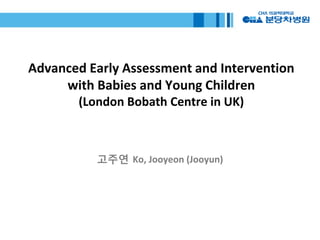Debriefing of Bobath Training at London UK 2014 (런던보바스후기)
- 1. Advanced Early Assessment and Intervention with Babies and Young Children (London Bobath Centre in UK) 고주연 Ko, Jooyeon (Jooyun)
- 2. Course aims and objectives  Apply the Bobath concept in early assessment and intervention to include current views on early treatment and management  Develop better facilitation/handling skills through problem solving  Develop better observation skills through video case studies  Gain an in depth understanding of normal, abnormal and atypical development for preterm and term babies in the first year of life 2
- 3. Course aims and objectives  Gain a greater understanding of the assessment tools / methods available to therapists in early intervention  Have an opportunity to learn about a developmental approach when working in NICU  Gain an in depth knowledge and understanding of early patterns of brain damage, investigation methods, medication and medical intervention  Gain a better understanding of normal feeding patterns and feeding difficulties in preterm infants and the implications for practice 3
- 4. Contents 1. Introduction to NICU 2. The Bobath concept 3. Typical development of term and pre-term 4. Observation of typically developing children 5. Brazelton concepts and their application to irritable children 6. Positioning 7. Developmental follow-up 4
- 5. 5 Bobath concepts or N.D.T  88% of neurological physiotherapists in the UK use Bobath approach.  It depends on when you trained, where and who with. (Davidson and Waters, 2000) That’s the reason why I had attended the London Course. 
- 6.  When therapist attending the pediatric course at the Bobath Centre are asked what Bobath, the reply usually concerns the use of techniques of inhibition of abnormal tone and movement patterns, facilitation of more normal movement, and possibly stimulation in case of hypotonia or muscle activity. These techniques should not be considered to be Bobath, and yet for most therapists Bobath these thechniques re Bobath. 6 Bobath concepts or N.D.T
- 7. 7 Bobath concepts or N.D.T 2014.06.01 ~ 2014.06.07 (Bobath concept in London)
- 8. Bobath concepts or N.D.T (1) 8 It is a neurodevelopmental approach to treat CP and other neurological conditions It addresses the problems resulting of impairment of the developing CNS affecting individualΓÇÖs sensory-motor, cognitive, perceptual, social & emotional development Attention
- 9.  Framework for clinical reasoning  Analysis and understanding of the individual’s sensori-motor function, tone and patterns of movement and the way these affect the individual’s ability to participate in everyday life  Knowledge of how the clinical features evolve, and is proactive working to minimize secondary problems  Education to enable ‘treatment’ to be combined into everyday management 9 Bobath concepts or N.D.T (2)
- 10. Bobath concept or N.D.T. (3) 10 Children with Cerebral Palsy  Presence of abnormal patterns of posture and movement resulting from early brain lesion and subsequent abnormal postural tone  CP is a persistent condition where atypical postural tone reflects the use of atypical patterns of coordination  These atypical patterns of coordination are determined by the original impairment of the CNS, the ways the person has learnt to develop postural stability and to interact with the environment and subsequent musculoskeletal changes Maes J-P, 2013
- 11. 11  Preparation for function - Systematic preparation for function - Muscle needs to be at the best length for activation - Functional goals (for child/ parents)  Tone Influence Patterns - Handling: affect changes using key point of control to reduce tone, stimulate, activate, facilitates) - Give the sensation of more normal movement - Autonomic / voluntary Bobath concept or N.D.T. (4)
- 12. 12  Problem solving approaches - Pleasure and success - Purposeful, play centered and goal directed activities - Give the opportunity for practise and repetition of normal activities to facilitate sensory motor learning - Use ‘child development’ as a reference and select which activity, sequences or part of a sequence are more useful to practice  Parent participation - Essential for carryover and management  Transdisciplinary approach - Teamwork (common goals): Therapists and doctors, and care- givers to reinforce the input into daily life Bobath concept or N.D.T. (5)
- 13. 세줄 요약 13 MANY THANKS. ^^  Bobath concept에 대한 치료사 각자의 이해 및 적용이 필요 (self-directed career development)  환자와 보호자가 참여할 수 있도록 치료와 교육의 역할 에 대한 책임감을 분담할 것(교육과 확인)  치료적 목표에 대하여 보호자와 현실적 토의가 필요함 작은 변화에 대한 주관적 만족감 ≥ 객관적 평가수치
- 14. References 14 ΓÇóMayston, M (2008) Editorial: Bobath concept: Bobath@50: mid-life crisis ΓÇô What of the future? Physiotherapy Research International 13(3)131-136 ΓÇóScrutton D, Damiano D, Mayston M. (2004) Management of the Motor Disorders of Children with Cerebral Palsy, 2nd Edition. No. 161. Cambridge University Press: ISBN 1 898683328 ΓÇóEdwards S. (2002) Neurological Physiotherapy: A Problem-solving Approach 2nd Edition.Churchill Livingstone ISBN 0443064407 (chapter 1: Problem solving in neurological physiotherapy: Setting the scene by Dr M. Mayston can be accessed as a sample chapter, on website: http://www.sld.cu/galerias/pdf/sitios/rehabilitacion/problem_solvin g_in.pdf MANY THANKS AGAIN. ^^














